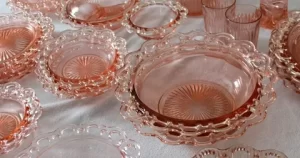Have you ever wondered about the history behind those stunning depression glass pieces? Or you’re a passionate collector looking to build up your collection of vintage treasures. Well, look no further! We were lucky enough to sit down with expert glass enthusiast and collector Jim Smith to get an in-depth look at the world of depression glass. From its origins as a symbol of hope during the Great Depression to its modern-day resurgence in popularity and value, join us as we explore the fascinating world of pink depression glass with Jim’s unique insight and expertise.
Who is an expert in Pink Depression glass?
Regarding Pink Depression glass, few people are more knowledgeable than Dr Lori Verderame. As an expert in antique and vintage collectables, she has appraised and consulted on some of the most iconic pieces of Depression glassware. In addition to her work as an appraiser, Lori is also a historian, author, and lecturer who has dedicated her career to educating people about the significance of this type of collectable.
As someone who has studied Depression glass for many years, Lori can provide valuable insight into its history, value, and collector appeal. As an expert, she is often called upon to appraise pieces of Depression glass for insurance purposes or estate sales. She is also frequently consulted by collectors looking to add Pink Depression glass to their personal collections.
Lori’s passion for Depression glass began at a young age when she inherited a set of dishes from her grandmother. Since then, she has been on a mission to learn everything she can about this type of collectable. Through her research, she has discovered that Depression glass is much more than just pretty dishes; it is a fascinating part of American history that deserves to be preserved and appreciated.
What are the different types of Pink Depression glass?
There are three main types of Depression glass:
1. Standard Pink Depression Glass – This is the most common type of Depression glass produced by various companies during the 1920s and 1930s. It is characterized by its light pink color and simple, elegant design.
2. Rose Pink Depression Glass – This type of Depression glass is rarer than standard pink and is usually produced by higher-end companies. It is characterized by its deep rose color and more intricate designs.
3. Royal Purple Depression Glass – This is the rarest type of Depression glass and was only produced for a short time by a few companies. It is characterized by its rich purple color and luxurious designs.

How to identify Pink Depression glass?
Depression glass is a type of glassware produced during the 1920s and 1930s. It is typically characterized by its Rose Pink color, although it can also be found in other colors, such as green, blue, and amber. Depression glass was made in various patterns and styles, which are still popular today.
There are a few ways to identify Depression glass. First, look at the color. Rose pink is the most common color for Depression glass, so if the piece you are looking at is pink, it is likely Depression glass. Second, look at the style and design of the piece. Depression glass was produced in various patterns and styles, which are still popular today. Finally, look for any markings on the bottom of the piece. Many manufacturers put their initials or logos on the bottom of their glasses, which can be another way to identify Depression glass.
Where to find experts in Pink Depression glass?
There are a few ways to find experts in Depression glass. One way is to go to antique stores or flea markets specializing in Depression glass. Another way is to search online for forums or message boards that discuss Depression glass. Finally, you can always ask around at local antique shows or conventions.
How to become an expert in Pink Depression glass?
To become an expert in Depression glass, it is important to first understand the history and production of the glass. Depression glass was produced during the Great Depression, lasting from 1929 to 1939. During this time, many factories closed, and millions of Americans lost their jobs. To save money, families began to reuse and recycle items like glassware.
Depression glass was made from leftover bits of other glass products, so it is often irregular in shape and color. The most popular colors are pink, green, and yellow. Blue and red are also common, but less so than the other three colors.
There are a few things to look for when identifying Pink Depression glass. First, look for the maker’s mark on the bottom of the piece. Many manufacturers placed their logos on the bottom of the glassware during this period. If there is no maker’s mark, that doesn’t necessarily mean that the piece is not Depression glass, but it makes it more difficult to identify.
Next, examine the color of the glass. As mentioned before, pink is one of the most common colors for Depression glass. However, some pieces may have faded over time or been damaged, so they may not be as pink as they once were. If you need more clarification on the color, hold the piece to a light source and look at it closely.








